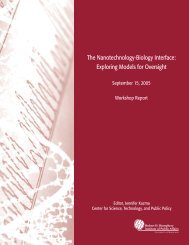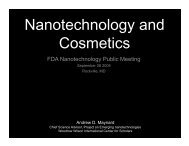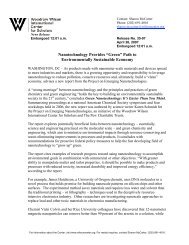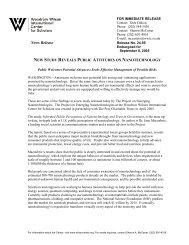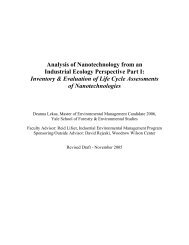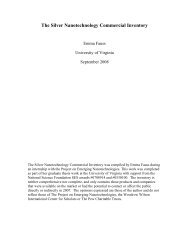nanotechnology oversight - Project on Emerging Nanotechnologies
nanotechnology oversight - Project on Emerging Nanotechnologies
nanotechnology oversight - Project on Emerging Nanotechnologies
Create successful ePaper yourself
Turn your PDF publications into a flip-book with our unique Google optimized e-Paper software.
FOREWORD<br />
The next presidential administrati<strong>on</strong> will face a<br />
host of complex policy issues c<strong>on</strong>cerning energy,<br />
the envir<strong>on</strong>ment, food safety, c<strong>on</strong>sumer products<br />
and the workplace. One issue, however,<br />
that will impact virtually all of these policy areas<br />
is <str<strong>on</strong>g>nanotechnology</str<strong>on</strong>g> <str<strong>on</strong>g>oversight</str<strong>on</strong>g>.<br />
Nanotechnology, the science and technology<br />
of manufacturing and manipulating materials<br />
at the tiniest of scales, creates endless<br />
opportunities to address the many significant<br />
social and ec<strong>on</strong>omic challenges facing<br />
Americans. But some new nanoscale materials<br />
may present unc<strong>on</strong>venti<strong>on</strong>al risks to c<strong>on</strong>sumers,<br />
workers, and the envir<strong>on</strong>ment.<br />
Therefore, without robust <str<strong>on</strong>g>oversight</str<strong>on</strong>g> mechanisms<br />
to underpin safe use, the full benefits of<br />
<str<strong>on</strong>g>nanotechnology</str<strong>on</strong>g> may never be realized.<br />
Today, more than 600 manufacturer-identified<br />
c<strong>on</strong>sumer products are available <strong>on</strong> the<br />
market using <str<strong>on</strong>g>nanotechnology</str<strong>on</strong>g>. In additi<strong>on</strong>,<br />
there are countless other commercial and industrial<br />
applicati<strong>on</strong>s of which the public and policymakers<br />
are not even aware. Unfortunately,<br />
federal agencies currently have to draw <strong>on</strong><br />
decades-old laws—many of which are woefully<br />
out of date—to ensure the safe development<br />
and use of these technologically advanced products.<br />
Federal officials need 21st century tools for<br />
cutting-edge technologies. Anything short of<br />
that is unacceptable and may leave the public<br />
unprotected from emerging risks.<br />
Given the rate of development and commercializati<strong>on</strong><br />
of nanotechnologies, time is of the<br />
essence. In order to ensure the safe development<br />
of this rapidly advancing technology, which is<br />
projected will enable 15 percent of globally<br />
manufactured goods worth $2.6 trilli<strong>on</strong> by<br />
2014, there needs to be an increase in funding<br />
for <str<strong>on</strong>g>nanotechnology</str<strong>on</strong>g> risk research in the fiscal<br />
year 2009 budget to $100 milli<strong>on</strong> and in FY<br />
2010 to $150 milli<strong>on</strong>. And through early<br />
administrative acti<strong>on</strong>, the next president should<br />
quickly implement new <str<strong>on</strong>g>oversight</str<strong>on</strong>g> mechanisms<br />
for <str<strong>on</strong>g>nanotechnology</str<strong>on</strong>g>. Such acti<strong>on</strong>s include collecting<br />
safety informati<strong>on</strong> <strong>on</strong> uses of nanomaterials<br />
in food producti<strong>on</strong> and packaging; updating<br />
federal occupati<strong>on</strong>al safety laws; and defining<br />
nanomaterials as “new” substances under<br />
federal laws, thereby allowing agencies such as<br />
the Envir<strong>on</strong>mental Protecti<strong>on</strong> Agency and the<br />
Food and Drug Administrati<strong>on</strong> to obtain more<br />
informati<strong>on</strong> <strong>on</strong> nanomaterials.<br />
The author of this report, J. Clarence Davies,<br />
has invested significant thought into <str<strong>on</strong>g>nanotechnology</str<strong>on</strong>g><br />
<str<strong>on</strong>g>oversight</str<strong>on</strong>g> issues in recent years. In this<br />
paper, he points to ways existing laws can be<br />
applied or changed, if necessary, to provide<br />
needed <str<strong>on</strong>g>oversight</str<strong>on</strong>g> of nanoscale materials. He also<br />
calls for an increase in resources to research the<br />
risks posed by these materials and outlines a<br />
plan for future study and <str<strong>on</strong>g>oversight</str<strong>on</strong>g>.<br />
The goal of this report is to highlight the<br />
importance of creating sensible <str<strong>on</strong>g>nanotechnology</str<strong>on</strong>g><br />
<str<strong>on</strong>g>oversight</str<strong>on</strong>g> policies and describe the acti<strong>on</strong>s that<br />
need to be taken by the next president. Many<br />
of the potential risks of nanoscale materials have<br />
already been identified, and for the world to<br />
realize the benefits of this technology the next<br />
administrati<strong>on</strong> must act swiftly and carefully.<br />
This will be a challenge, but <strong>on</strong>e that could have<br />
limitless opportunities to improve the world in<br />
the 21st century. This report provides a blueprint<br />
for early acti<strong>on</strong> by the next White House<br />
and key regulatory agencies.<br />
David Rejeski<br />
Director<br />
<str<strong>on</strong>g>Project</str<strong>on</strong>g> <strong>on</strong> <strong>Emerging</strong> <strong>Nanotechnologies</strong><br />
iii



